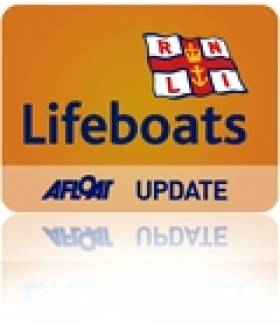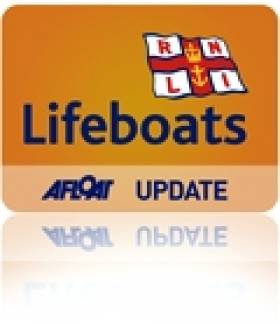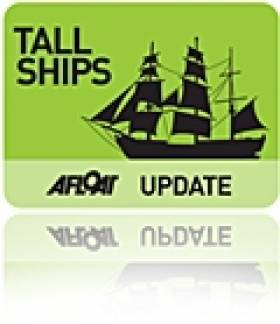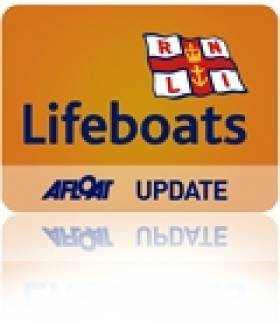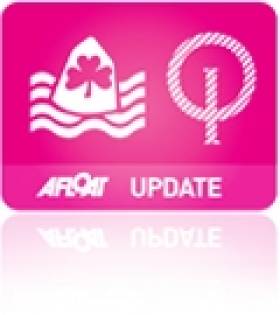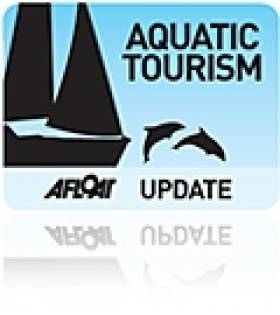Displaying items by tag: Baltimore
Shouts from a Cave Lead Baltimore Lifeboat to Kayakers
#lifeboat – At 00:30 this morning, after a search of many hours for two kayakers who had been reported missing from Rosscarbery, shouts were heard from a cave near Millcove. Baltimore Inshore Lifeboat Helm John Kearney investigated and found the two 17 year old males who had taken shelter in the cave. A smaller Y boat was launched from the all weather lifeboat Alan Massey which ferried the boys individually from the cave and then onto the inshore lifeboat which landed the teenagers at Millcove. Both RNLI Lifeboats are now returning to station in Baltimore.
Additional report from Baltimore lifeboat station on Sunday 1500hrs
Further details have emergered on the dramatic events of last night (Saturday 4 August 2012) and early this morning which saw two young kayakers rescued after they became trapped in Mill Cave, West Cork. The rescue involved a Baltimore RNLI crewmember swimming into a narrow cave in challenging sea conditions and bringing the two young kayakers to safety.
The two teenagers, a boy and a girl, had been reported missing from Rosscarbery on Saturday evening after they had not returned home at their expected time. A huge search was mounted involving Balimore RNLI and Irish Coast Guard Units.
At 23:00, while the search was ongoing, Baltimore RNLI lifeboat Helm John Kearney heard what he thought was a faint whistle coming from Pouladav cave, known locally for its' blowhole. The lifeboat crew were aboard the RNLI Atlantic 75 inshore lifeboat Bessie but could not enter the cave due to the dangerous surf conditions. The lifeboat crew then launched a small boarding boat from their all weather lifeboat Alan Massey with volunteer crewmembers Ger Sheehy and Sean McCarthy. This smaller boat could only advance within 50 metres of the cave summit due to the area being awash with surf and again too dangerous. RNLI crewmember John Kearney, an experienced sea swimmer, went into the water and swam the last 50 metres to reach the two kayakers. The boy and girl were clinging to a rock surface while waves broke around them.
Both the young people were cold and tired. John carried each of them in turn over his shoulder in chest high water to the boarding boat. Considerable skill was required of Ger Sheehy to keep the small boat steady so that they could be retrieved with the assistance of Sean McCarthy. The teenage girl and boy were then taken to the inshore lifeboat, where they were given a medical assessment and deemed to be fit to return to shore. The inshore lifeboat brought them directly to their families at Mill Cove, where they were assessed by a Doctor. The girl and boy were taken onboard the inshore lifeboat, which then brought them directly to their families who were anxiously waiting at Mill Cove. The entire incident took place in the hours of darkness
Commenting on the rescue Baltimore RNLI Helm John Kearney said, "the water in the cave was churning like a washing machine. However I was convinced that I had heard a sound and was concerned for the safety of the kayakers. I will never forget the relief I felt when I saw the two young people alive and safe inside the cave. They were very brave and did exactly what they needed to do to get to safety. We are very lucky to have two lifeboats in Baltimore, and by using all of our available resources and training we were able to bring these young people to safety."
Baltimore Lifeboat Tows Yacht to Union Hall
#RNLI – A yacht with engine difficulties just two miles east of Adams Island near Glandore Harbour, West Cork made a call for assistance as variable wind conditions impeded its progress. The alarm was raised last night at 20:04.
Baltimore lifeboat responded. The Tamar class lifeboat (with a top speed of 25 knots) made good speed to rendezvous with the distressed vessel.
Coxswain Kieran Cotter assessed the situation of the two male yachtsmen on board the 35–foot yacht and decided the best course of action was to tow the yacht into Union Hall 65 minutes away. Having secured the yacht safely the lifeboat returned to Baltimore.
On board the lifeboat were Coxswain Kieran Cotter, Cathal Cottrell, Micheal Cottrell, Jerry Smith, Diarmuid Collins and Brian McSweeney
#RESCUE - Brave volunteers from the Baltimore RNLI saved the day when they jumped aboard a runaway speedboat heading for a busy pier last Friday.
As the Irish Examiner reports, it was one of four dramatic rescues made by the West Cork lifeboat crew in a single 24-hour period.
Pat Collins and Tadhg Collins were the plucky duo who attempted the daring feat from their inflatable boarding boat launched from the all-weather lifeboat.
They manoeuvred their boat close enough to the runaway RIB - which was circling at speeds of up to 20 knots ever closer to the pier after its pilot and passenger were thrown overboard - to allow Tadgh to leap on board and turn down the engines.
The RIB's crew were unharmed in the incident, swimming away and finding shelter on a ketch anchored at Sherkin Island.
Baltimore's busy 24 hours continued with call-outs from three yachts during Saturday's force 7 easterly winds.
The Irish Examiner has more on the story HERE.
#LIFEBOATS - The latest marine notice from the Department of Transport, Tourism and Sport (DTTAS) advises of construction work being carried out on Baltimore Lifeboat Station from today 5 March.
As previously reported on Afloat.ie, the works are part of a €2.6 million State-funded project to conduct essential remedial works at harbours across West Cork this year.
The works - which will be ongoing till mid-October pending weather conditions - will involve piling immediately adjacent to the foreshore on the north-east side of the building, and the deposition of rock to form an armoured breakwater jutting some 80m into Church Strand Bay.
No forseeable impact to mariners in the area is expected, but vessels are in any case requested to proceed slowly and with caution in the approach channel to Church Strand Bay and to give the works a wide berth to avoid wave-wash.
Further details for mariners are included in Marine Notice No 9 of 2012, a PDF of which is available to read and download HERE.
Sailing Clubs Share in €2.6m Announced for West Cork Harbours
#WEST CORK – Sailing Clubs stand to benefit in an allocation of over €2.6 million to harbour boards across West Cork this year to fund essential remedial works. The State funding has been approved for harbour development works in Skibbereen, Baltimore, Kinsale and Bantry by the Department of Transport, Tourism and Sport.
In Baltimore a Sailing Club Slipway extension has been allocated €35,000 and in Bantry a Sailing Club Pontoon will get funding of €70,000. See full breakdown below.
In many cases works might involve the completion of a slipway or the construction of a pontoon adding to some other marine leisure developments along the Cork coast over the last 12 months. Royal Cork Yacht Club announced this month a five star grading for its marina in Crosshaven and elsewhere in Cork harbour a new marina has been built at Monkstown.

Development works underway at the harbour in Baltimore this week. Photo: Tom MacSweeney
The announcement by Minister Leo Varadkar sees the Baltimore and Skibbereen harbour board and the Kinsale harbour board each receive €1.25 million to fund essential remedial works. The Bantry Bay harbour commission will also receive €140,000.
This is a substantial investment that will considerably improve the operational capacity of each harbour, which will in turn have positive knock-on effects for the local economy and the environment.
The Baltimore and Skibbereen harbour, and the Kinsale harbour were recently transferred from the Department of Transport to Cork County Council and as part of that process, a two-year commitment to fund essential remedial works by the Department was agreed.
Local TD Michael McCarth of the Labour party said "I welcome the allocation of these monies and am glad the Government continue to recognise the importance of up-keeping and maintaining our local harbours, which are often important focal points for rural communities."
Harbour Funding 2012
Baltimore & Skibbereen
Western Pier final account €39,000
RoRo Slipway final account €21,000
North Pier extension final account €25,000
North Pier Phase 1 final works and account €150,000
North Pier Phase 2 works underway €745,000
Sailing Club Slipway completion of works €35,000
Proposed Inner Harbour Pontoon €70,000
Breakwater Design completion €30,000
Foreshore Licence Fees €135,000
€1,250,000
Kinsale
Commercial Town Pier contract retention €30,000
Adam’s Quay completion of work on site €555,000
Lobster Quay works completion €90,000
Fisherman’s Pontoon Remedial Works €140,000
Commercial Pier extension Phase 1 €435,000
€1,250,000
Bantry Bay
Sailing Club Pontoon €70,000
Pier Derrick €70,000
€ 140,000
Sail Training Schooner Locked Up Since 2007
#TALL SHIPS - The flagship vessel for an Asgard-type sail training programme in Cork has been locked up in a boatyard since 2007, the Irish Examiner reports.
The Omar B was supposed to be the focus of a Youthreach project based in Bantry for early school leavers. But the schooner has spent the last four-plus years in storage in Baltimore, and has been deteriorating due to lack of maintenance - despite the scheme still notionally running, the newspaper report says.
Five two-man dinghies purchased with grant money have also reportedly spent most of 2011 in storage.
Co Cork's VEC has now put the €150,000 sailing programme under review following concerns over storage costs and lack of direction for the project.
The 75ft Omar B was donated to the CCVEC by owner and builder Don Attig in 2003 and refitted for use by students thanks to generous voluntary funding. Attig said the boat was of immense benefit to students who would not otherwise be in education.
The Irish Examiner has much more on the story HERE.
Lifeboats Receive 1,000 Calls for Help in 2011
#LIFEBOATS – RNLI Lifeboats in Ireland launched 980 times to a variety of call outs in 2011. 905 people were rescued over the course of the year by volunteer lifeboat crews who spent over 9,826 hours on service at sea.
Howth RNLI lifeboat station in Dublin was the busiest coastal Irish station, launching to 48 requests for help and, bringing 60 people to safety. They were followed by Crosshaven RNLI in Cork who launched 46 times and assisted 43 people. Enniskillen, one of Ireland’s two inland RNLI lifeboat stations which operates bases on both Upper and Lower Lough Erne, launched 52 times and brought 46 people to safety.
The busiest month for rescues was July with 155 launches followed by August with 124 calls for assistance. February 2011 was the busiest February for Irish launches in the RNLI’s history, as were May and October 2011.
Over a third of the RNLI’s call outs for last year were also carried out in darkness. The statistics show that launches to vessels suffering machinery failure still account for the largest number of call outs (187) followed by vessels reported to be in trouble (78), grounded (74) and capsizing (73).
Commenting on the 2011 statistics RNLI Deputy Divisional Inspector Gareth Morrison said: ‘Our lifeboat volunteers continue to show selfless dedication and commitment to saving lives. Some stations are extremely busy while others have less call outs but spend long hours at sea in awful conditions. There were some outstanding rescues last year including that to Rambler 100, in which Baltimore RNLI recovered 16 crew members off the upturned hull of the racing boat during the Fastnet race. Sadly there were also long searches for missing loved ones.
‘The work of the volunteer lifeboat crews could not be made possible without the generosity of the public who in difficult times continue to support Irish lifeboat crews. While these figures give an interesting insight into search and rescue by the RNLI on Irish waters they are by no means the full story. As well as working to save lives at sea the RNLI provides other programmes and services for the public including sea safety advice and clinics, education roadshows and visits to lifeboat stations.’
The 2011 figures are being released in the wake of the RNLI Lifejackets for Lifesavers campaign which will see every lifeboat station in Ireland take delivery of new specially designed lifejackets in September. The lifejackets have been commissioned by the RNLI for search and rescue work and have been given the seal of approval from lifeboat volunteers. The cost of providing the lifejackets for all 43 lifeboat stations in Ireland is estimated at €160,000.
Optimist Class Seek New Talent in Baltimore
#optimist – Impressed with the sailing success of 14-year-old Sophie Browne in New Zealand this week? Could you be the next to represent Ireland on the world stage? The Irish Optimist class is making every effort to bring on as many 'Oppy' sailors as possible with an Invitation to all Optimist sailors to its 2012 Spring Training Week in Baltimore from 13-17 February 2011, the school half-term.
IODAI, the International Optimist Dinghy Association of Ireland, organises a Spring training week every year which is open to all Optimist sailors in Ireland.
Baltimore in West Cork sits near the very southern tip of Ireland on the beautiful southwest coast roughly mid-way between the busy tourist destination of Dingle and Kinsale. Slightly off the tourist trail, Baltimore has restrained a village atmosphere, but it still has plenty of top class accommodation and a great place to eat and drink.
The village of Baltimore will be taken over by approximately 150 sailors and their families for the week of February mid-term. Coaches have not yet been announced, but typically are a mix of the top Irish and international coaches; in 2011, the Irish coaches were joined by coaches from Denmark, Spain and Italy.
Training will be provided daily for sailors of all competencies, from those who have never sailed before – pre-Regatta fleet level - to those who are competing internationally.
The class particularly would like to encourage sailors who have not attended an event outside their own club in the past, to consider coming to Baltimore, which is a non-competitive, fun week intended to build enthusiasm for sailing and to allow sailors from around the country to get to know each other.
The Baltimore event is considered to be one of the top International clinics in Europe.
It is very much a family-oriented event, with a programme of activities for children too young to sail, and events also organised for adults, such as the 'How to Rig an Oppi' class for novice parents!
The event is organised by IODAI which is comprised of volunteers, mainly parents of sailors, who organise the Optimist events calendar. Because everyone is a volunteer, Baltimore is an 'all hands on deck' week, with parents encouraged to lend a hand with the work that goes into making it such a special event. Helping out with making sailors lunches, doing slip duty, rescue on the water, or safety checking of boats, means that parents will get to know each other just as well as the sailors do.
Evening activities are also on offer, including the ever-popular 'Pizza night with the Coaches', tours of the Baltimore castle and RNLI station, and cinema night. And of course the cake competition on the last day of sailing.
An IODAI forum takes place during the Baltimore week where all parents are invited to express their views or seek information on the running of the Optimist class.
Entry is open to all interested sailors and entry can be made through the online Sailracer system, or directly by contacting the organiser Aidan Staunton at [email protected].
Baltimore has accommodation to suit our Sailors with a wide selection of Holiday homes, Apartments, Bed & Breakfast and Casey Hotel. Families can choose somewhere near the harbour or centre of the town. Accommodation can be booked on www.baltimore.ie where you will find a comprehensive list of accommodation.
Cork The Place to Be For a Holiday On The Sea
#TOURISM - Winter might be upon us, but it's a great time to plan a new year holiday in Ireland on the sea, according to the UK's Daily Echo.
From night-time paddling in with renowned kayaking instructor Jim Kennedy, to snorkelling in Baltimore, relaxing in Skibbereen and and fresh seafood lunches in Kinsale, a vacation in Cork can appeal to any taste.
Whale and dolphin watching is a big draw for the region, too, as Ireland's coast – the first cetacean sanctuary in Europe - plays host to a growing variety of species.
The summer feeding grounds off the southern coast are particularly busy, and tourist boats are often treated to whales breaching the surface and surrounded by dolphins putting on a show.
The Daily Echo has more on the story HERE.
First Sighting of a Dolphin in an Irish Lake
#MARINE WILDLIFE - The first recorded sighting of a dolphin in an Irish lake has been reported by the Irish Whale and Dolphin Group (IWDG), according to The Irish Times.
The dolphin was spotted in Lough Hyne, a saltwater lake near Baltimore in Co Cork by Skibbereen-based kayaking instructor Jim Kennedy, who filmed it over a number of days.
"To the best of my knowledge, and I’m open to correction, this is the first validated record of a cetacean using an Irish lake," said the IWDG's Pádraig Whooley.
Though there have been no further sightings since then, there is nothing to indicate that the dolphin has yet left the lough for the open sea.
As previously reported on Afloat.ie, Lough Hyne was also recently visited by a 13-metre fin whale that was sadly found beached in stormy conditions on the Sligo coast this week.
The Irish Times has more on the story HERE.



























